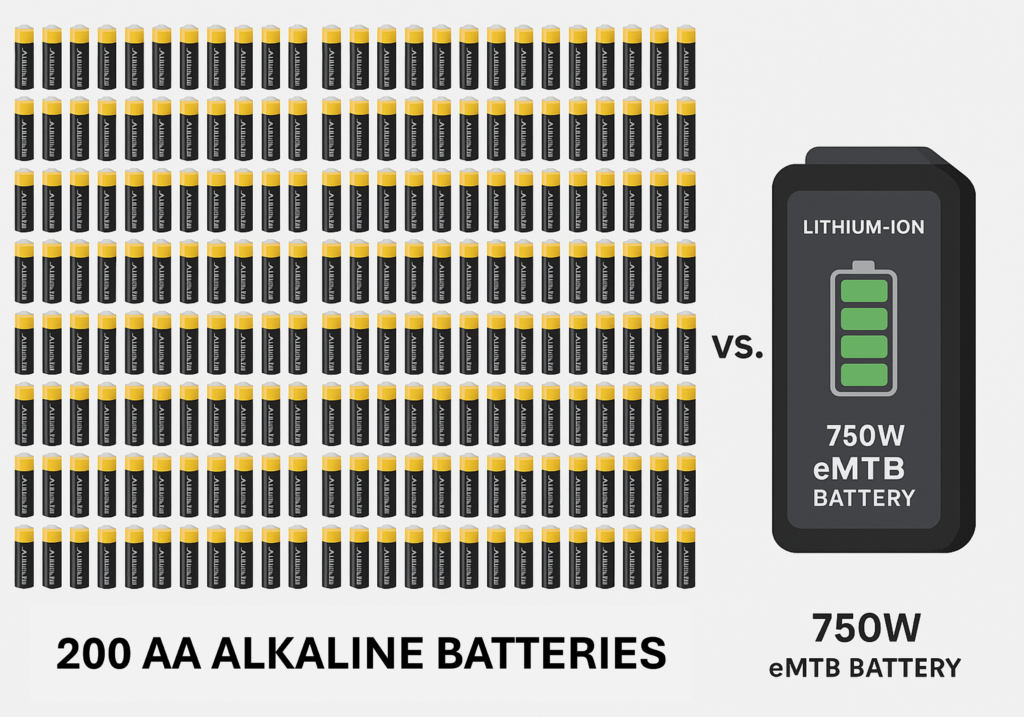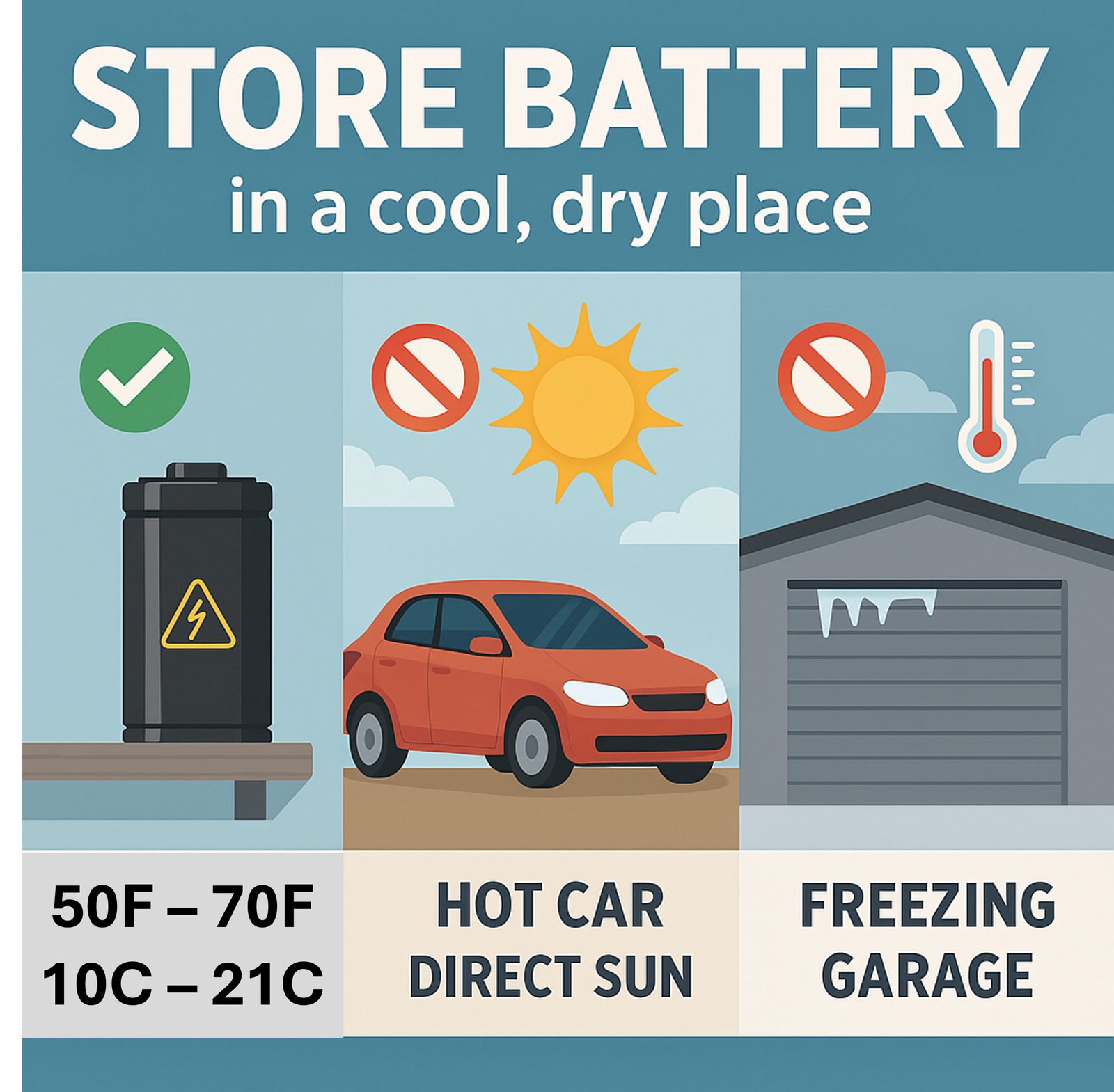EMTB batteries are large, heavy, and expensive. However, they are also sophisticated electronic devices that deliver a lot of power for their size. In a previous blog post, we looked at Watts – how battery power is measured. In today’s post, we will dive into what is actually going on inside of your eMTB battery, and ways that we can help them last as long as possible.
A Brief History of Batteries
Believe it or not, battery technology has been around for well over 200 years! It all began in 1800 when Alessandro Volta invented the first true battery, the Voltaic Pile. This early battery used alternating layers of zinc and copper, separated by saltwater-soaked cloth, to produce a steady electric current. It was the first time humans created continuous electricity on demand – at least historically, I got your back, Ancient Alien theorists – and it’s why we use the term “volt” today.
Even more amazing, is that the principal science behind batteries has not changed. Why mess with a good thing, right? All batteries, whether it’s the Voltaic Pile or your e-bike battery, rely on the same core concept:
Chemical reactions move electrons and ions between two materials to create electricity.
Every battery has:
- A positive side (cathode)
- A negative side (anode)
- A medium (electrolyte) that lets ions move but blocks electrons
- An external path for electrons to flow (creating current)
So, in Volta’s battery, zinc and copper created a chemical reaction that pushed electrons through a wire. In lithium-ion batteries, lithium atoms do the same kind of job, but much more efficiently.
Throughout the 1800s, scientists like Michael Faraday continued exploring electrochemistry, leading to more stable designs like the Daniell Cell and Grove Cell.
By the 1860s, the lead-acid battery had been developed by Gaston Planté, becoming the first rechargeable battery—a format still used today in vehicles and for solar and backup power systems. The 1900s saw the rise of portable batteries, especially with the invention of alkaline batteries in the 1950s. These powered everything from flashlights and radios to toys. Then came a major leap in the 1980s and 1990s with the development of lithium-ion batteries by researchers like John B. Goodenough (for real, that is his name) and Akira Yoshino. Sony commercialized the technology in 1991, changing the game for portable electronics and paving the way for applications like electric vehicles and e-mountain bikes.
Today, your eMTB battery is lithium-ion, the gold standard for most high-performance, rechargeable devices. They offer high energy density, long life, and efficiency—and engineers are continuing to improve them. Current innovations include solid-state batteries, ultra-fast charging, and the use of more sustainable materials. While battery tech dates to 1800, the lithium-ion cells powering your eMTB only came on the scene in the 1990s and are still evolving fast.
Lithium-Ion Batteries – eMTB Enablers
The impact of Lithium-Ion batteries cannot be understated, at least when it comes to e-mountain biking. Without them, we would not have the sport! Lithium-Ion batteries, with their ability to recharge hundreds and even thousands of times, are the heart of our bikes. Imagine trying to power an eMTB without them. Your choices would pretty much be between using a heavy, dangerous lead-acid car battery or duct taping together hundreds of AA batteries together – only to throw them out after each ride!

Lithium-Ion batteries also have other distinct advantages over alternative batteries:
- Low internal resistance
→ This means they lose very little energy as heat, allowing them to deliver power efficiently even under heavy loads. - Are built for high current draw
→ They’re designed to release large amounts of current quickly, making them ideal for powering motors in demanding applications like eMTBs. - Can safely and repeatedly deliver bursts of power
→ Lithium-ion cells are engineered to handle rapid charge and discharge cycles without degrading quickly or risking instability. - Are smart managed with a BMS
→ The Battery Management System monitors and balances the cells, prevents overheating, and monitors performance.
What Is a Battery Management System (BMS) in an eMTB?
A Battery Management System (BMS) is the onboard computer that monitors and controls the performance of a battery pack. It ensures safe operation by tracking voltage, current, and temperature across all cells. The BMS balances the cells during charging to maximize lifespan and efficiency. It can also shut down the system if it detects any risk of damage or failure. In an eMTB, the BMS plays a critical role in delivering smooth, reliable power while protecting both the rider and the battery.
When you power on your electric mountain bike, the Battery Management System (BMS) kicks into gear. This built-in safety computer instantly checks voltage, temperature, and charge levels across all cells. If everything looks good, it gives the green light to begin operation.
Next, the battery releases DC voltage to your bike’s motor controller, adjusting power output based on how hard you pedal or use the throttle. The voltage creates the push, and the current (amps) responds to your riding demands.
While you ride, the BMS is in constant communication with your bike’s system—relaying key stats like charge level, temperature, and fault codes to your handlebar display or companion app. It also actively balances cell performance and monitors for overheating, low voltage, or other safety issues, shutting down the system if needed.
As terrain changes, the motor draws more power. The battery and BMS work together to deliver current safely and efficiently, ensuring a smooth and responsive ride.
In short: Your eMTB battery is smart. It doesn’t just store energy—it actively manages, monitors, and protects your bike’s power system every second you ride.
How to Extend the Life of Your eMTB Battery: Care & Charging Tips
The average eMTB battery lasts up to 1,000 full charge cycles, which typically translates to 3 to 5 years of use.
However, actual lifespan depends on several factors:
- How often you ride (and how hard)
- How you charge it (partial charges are easier on the battery)
- Storage habits (cool, dry places are best)
- Battery quality (premium brands like Bosch or Shimano usually last longer)
🔋 A well-cared-for lithium-ion eMTB battery can still hold 70–80% of its original capacity after hundreds of cycles.
The more frequently you drain and recharge your battery—especially with high power output (steep climbs, turbo mode, heavy loads)—the more wear you put on its cells. Riders who regularly push their motor to its limits may hit the end of the battery’s useful life faster than riders who stick to lower modes on flatter terrain.
Charging practices make a big difference. Partial charges (20% to 80%) are gentler on lithium-ion batteries than charging to 100% or letting them drain to 0%. Also, slow charging is less stressful than fast charging and unplugging the battery once it’s full helps prevent overcharging stress.

Batteries last longer when stored in cool, dry environments, ideally around 50°F to 70°F (10°C to 21°C). Avoid leaving your battery in a hot car, direct sun, or freezing garage, as extreme temperatures speed up chemical aging. If you’re not riding for weeks or months, store the battery at around 50–60% charge.
Not all batteries are created equal. High-end eMTB systems use top-tier lithium-ion cells and advanced Battery Management Systems (BMS), which help extend life and maintain performance. Cheaper, generic batteries may save money up front but tend to degrade faster, offer inconsistent performance, and lack safety features.
As always, when it comes to battery maintenance, following manufacturer guidelines is the best practice!
Poorly manufactured or improperly handled lithium-ion batteries can lead to dangerous situations, including strandings and even fires. Multiple cities, including New York City, have enacted regulations governing the sale and storage of e-bikes. As an eMTB owner, you are a steward of the sport – and should take responsibility for proper use and storage of your investment. A bad reputation combined with bureaucratic ignorance can lead to restrictions on where and how we can use our bikes!
Lithium-Ion Powered Smiles, Up HILL!
Your eMTB battery is more than just a power source—it’s a finely tuned system of chemistry, and engineering. It enables us to enjoy every climb, descent, and mile of trail. Understanding how it works and what it needs to perform at its best can help you ride farther, safer, and have more fun. With the right care and habits, your battery will reward you with reliable power and minimal maintenance.
As eMTBs continue to grow in popularity, so does our responsibility as riders. By taking battery safety seriously, we help preserve the sport’s reputation and protect access to the trails we love. Using proper charging techniques, buying quality systems, and storing your bike responsibly goes a long way! Whether you’re a weekend warrior or a daily commuter, taking care of your eMTB battery takes care of our sport!
Do you feel supercharged? Did I leave anything out? Let me know, I love hearing from my readers!

